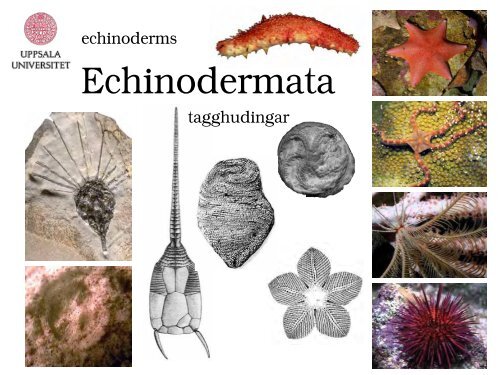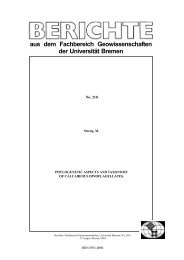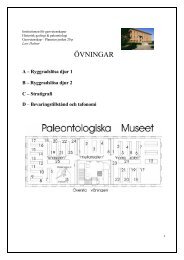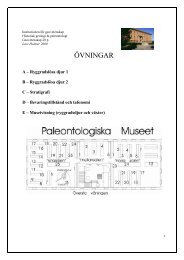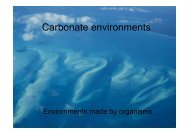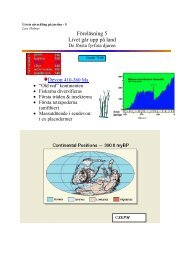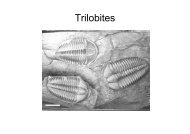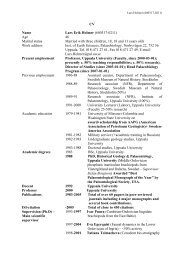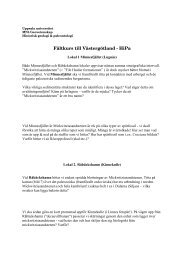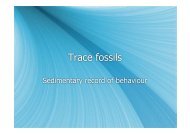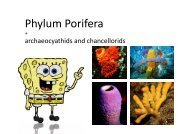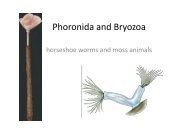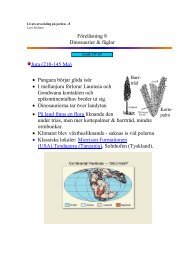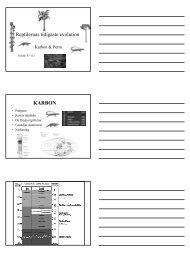Phylum Echinodermata
Phylum Echinodermata
Phylum Echinodermata
Create successful ePaper yourself
Turn your PDF publications into a flip-book with our unique Google optimized e-Paper software.
echinoderms<br />
<strong>Echinodermata</strong><br />
tagghudingar
general things<br />
<strong>Echinodermata</strong>
<strong>Echinodermata</strong> Klein, 1734 ex Bruguière, 1789<br />
Ethymology: Greek echinos (hedgehog, spine) and derma (integument, skin)<br />
Main characteristics:<br />
all echinoderms have a mesodermal skeleton of porous calcite plates<br />
but: reduced to absent among some holothuroids<br />
skeleton covered by a thin skin Endoskeleton<br />
radial symmetry, typically five-rayed / pentameral, as adults<br />
but: not developed in stem-group echinoderms, or carpoids<br />
lost or obscured by secondary adaptations<br />
water-vascular system (complex internal apparatus of tubes and bladders containing fluid)<br />
with extensions emerging through the skeleton to the outside as tube feet or podia<br />
(podia serve for locomotion, respiration and feeding a.o.)<br />
but: has not been confirmed in all fossil groups<br />
<strong>Echinodermata</strong> – general features
Porous calcite plates (ossicles)<br />
intracellular<br />
reducing the ossicle-producing stroma cell to a thin layer that lines the skeletal meshwork (stereom).<br />
each ossicle is a monocrystal<br />
high-magnesium calcite, which is a spathic mineral (crystalline with strong cleavage)<br />
• spathic fracture has been changed to conchoidal by inserting organic macromolecules<br />
into the crystal lattice<br />
• each ossicle is composed of two interlocked networks, one composed of<br />
mineral matter (stereom) and the other, of organic matter of mesodermal origin (stroma).<br />
• the trabecular structure of the stereom does not allow cracks to propagate<br />
farther than the next cavity<br />
• in fossils, pores of the stereom have become closed by diagenetic calcite in optical continuity.<br />
<strong>Echinodermata</strong> – general features – ossicles<br />
epidermis<br />
stroma<br />
stereom
Ossicles ...<br />
... can be fused into a test (sea urchins, crinoids)<br />
... can spread apart (sea cucumbers)<br />
... can be intermediate and variable (sea stars)<br />
<strong>Echinodermata</strong> – general features – ossicles
Exceptions! Primary polycrystalline calcite in ...<br />
<strong>Echinodermata</strong> – general features – ossicles<br />
... the cortex of primary spines of Cidaridae<br />
... tooth sceleton of Clypeaster<br />
... the accessory calcareous structures<br />
… filling the crevice fold in the chewing<br />
… areas of Diadematoida teeth.<br />
Cortex (primary polycrystalline)<br />
disturbed crystal structure (secondary!)
Water vascular system (= ambulacral system)<br />
Hydraulic system of fluid-filled canals<br />
• internal transport<br />
• locomotion<br />
• gas exchange<br />
• food capture<br />
• excretion<br />
• fluid similar to seawater and is moved<br />
through system with cilia<br />
Podia – tube feet<br />
• suction cups at the end<br />
• each tube foot works independently<br />
• moved by muscles and hydraulics<br />
Madreporite<br />
• perforated platelike structure which acts as the inlet for the water vascular system<br />
• (important for orientation, arms/ambulacralia)<br />
Stone canal<br />
• lime-walled tube which connects ring canal and madreporite<br />
<strong>Echinodermata</strong> – general features – water vascular system<br />
[Latin ambulacrum, walk planted with trees, from ambulare, to walk.]
<strong>Echinodermata</strong> – general features – water vascular system
ambulacra<br />
<strong>Echinodermata</strong> – general features – water vascular system
Other fearures:<br />
non-segmented<br />
no head<br />
open blood system<br />
nervous system simple without nerval center<br />
light sensors/eyespots but no eyes<br />
reproduce sexually (produce sperm and eggs)<br />
and asexually (regenerating lost parts)<br />
<strong>Echinodermata</strong> – other features
Ecology<br />
exclusively marine and stenohaline<br />
typically benthic (infaunal, epifaunal) but a few pelagic (planktonic and<br />
pseudo-planktonic) forms exist<br />
live free (vagile, floating, or active swimming) or attached (sessile)<br />
live on all kinds of substrates, littoral to abyssal, in all latitudes<br />
(today typical in shallow coastal waters and ocean trenches)<br />
carnivorous / herbivorous / detritus eaters<br />
<strong>Echinodermata</strong> – ecology
<strong>Echinodermata</strong> – ecology
<strong>Echinodermata</strong> – ecology
Luidia ciliaris (Asteroidea)<br />
Echinocardium cordatum (Echinoidea)<br />
<strong>Echinodermata</strong> – ecology<br />
Heterometra sp.<br />
Amphiura brachiata (Ophiuroidea, brittle star)
systematics<br />
<strong>Echinodermata</strong><br />
1) Stem-group <strong>Echinodermata</strong>
Echinoderm classification<br />
Arkarua adami from the Ediacaran Hills of Australia<br />
oldest putative echinoderm<br />
Reference:<br />
Gehling, J.G. 1987. Earliest known echinoderm - a new Ediacaran fossil from the<br />
Pound Subgroup of South Australia. – Alcheringa, 11:337-345.<br />
<strong>Echinodermata</strong> – classification
Helicoplacoidea (Lower Cambrian)<br />
spirals of overlapping ossicles<br />
"mouth" was a long groove that also spiralled around their body<br />
lived probably in burrows and extending their bodies outward to feed<br />
three ambulacra<br />
complete fossils only found in the White Mountains in California<br />
Reference:<br />
Dornbos, S. Q. & Bottjer, D. J. 2000. Taphonomy and environmental distribution of<br />
helicoplacoid echinoderms. – Palaios, 16: 197-204.<br />
<strong>Echinodermata</strong> – classification – Helicoplacoidea
Mixed ossicles (Lower Cambrian)
Homlozoa systematics<br />
<strong>Echinodermata</strong><br />
2) Homalozoa
Homalozoa [= Calcichordata, Carpoidea] (Middle Cambrian – Middle Devonian)<br />
bilateral or asymmetical<br />
main body (theca) constructed of two types of ossicles: marginalia and centralia<br />
theca typically flattened and with appendages (stele, aulacophore)<br />
use of appendages unknown (locomotion, feeding, tail for swimming etc.)<br />
Four main groups can be distinguished<br />
Ctenocystoidea – Homostelea (=Cincta) – Homoiostelea (= Soluta) – Stylophora<br />
<strong>Echinodermata</strong> – classification - Homalozoa<br />
[incl. Mitrata,<br />
Cornuta,<br />
Ankyroida]
marginalia<br />
presumed mouth<br />
”arm” =? ambulacrum<br />
centralia<br />
<strong>Echinodermata</strong> – classification - Homalozoa<br />
presumed anus<br />
proxi- mesi- dististele<br />
stele, aulacophore (tripartite)<br />
anterior? posterior?
Stylophora, Ankyroida<br />
Stylophora, Cornuta<br />
<strong>Echinodermata</strong> – classification - Homalozoa<br />
Homoiostelea<br />
Homostelea<br />
Ctenocystoidea
Calcichordate theory (Jefferies 1986):<br />
Chordates (ourselves) evolved from homalozoan echinoderms<br />
Stele=tail<br />
Calcite skeleton was replaced by an apatite one<br />
Theory more or less abandoned by now
systematics<br />
<strong>Echinodermata</strong><br />
3) Pelmatozoa
Pelmatozoa (since Middle Cambrian)<br />
”attached living”, stalked echinoderms (some secondarily freeliving)<br />
cup-shaped head (the calyx)<br />
attached to the calyx are arms (brachiols/brachia)<br />
the calyx is usually connected<br />
oral plates<br />
tegmen<br />
to the bottom via a stem<br />
pentamere or radial symmetry<br />
Three main groups:<br />
Cystoidea<br />
Blastoidea<br />
Crinoidea (sea lilies)<br />
<strong>Echinodermata</strong> – classification – Pelmatozoa<br />
theca<br />
calyx<br />
stem<br />
nodal<br />
internodal<br />
’arm’<br />
brachium<br />
brachiol<br />
columnars
Cystoidea (Ordovician to Devonian) [kristalläpplen]<br />
respiratory ”pore structures” traversing the plates of the theca<br />
pore structures are basis for taxonomy<br />
theca often slightly irregular<br />
stem short or absent<br />
well defined ”anal pyramid” surrounded by trigonal anal plates<br />
laterally to perioral plates<br />
hydropore (slit near the perisome, probably entrance of water vascular system)<br />
arms are non-branching, biserial brachiols<br />
two pore types typify the two main groups of cystoids<br />
Diploporita Rhombifera<br />
<strong>Echinodermata</strong> – classification – Pelmatozoa – Cystoidea<br />
diplopores dichopores<br />
rhomb-shaped contour
[anal pyramid, brachiols, dichopores]<br />
<strong>Echinodermata</strong> – classification – Pelmatozoa – Cystoidea
Blastoidea (Early Cambrian/Ordovician to Permian)<br />
typically with pentamere symmetry<br />
short stem (rarely preserved)<br />
crown of brachioles (rarely preserved)<br />
typical plating pattern:<br />
3 basal plates (BB) – 5 radial plates (RR) – 5 deltoid plates (Δ) –<br />
5 lancet plates below ambulacra<br />
star shaped mouth surrounded by spiracles (”outlet system”)<br />
<strong>Echinodermata</strong> – classification – Pelmatozoa – Blastoidea<br />
anispiracle
Blastoidea sensu stricto<br />
<strong>Echinodermata</strong> – classification – Pelmatozoa – Blastoidea<br />
Eocrinoidea (Early Cambrian to Silurian)<br />
Gogia palmeri
Crinoidea (since Ordovician)<br />
Most common palaeozoic<br />
echinoderm fossils<br />
Long stems<br />
Crinoid “meadows” in shallow water<br />
Disarticulated stems rockforming
Crinoidea (since Ordovician)<br />
radials<br />
basals<br />
radials<br />
basals<br />
infrabasals<br />
organized in stem, theka and brachia with ambulacra<br />
monocyclic calyx<br />
dicyclic calyx<br />
<strong>Echinodermata</strong> – classification – Pelmatozoa – Crinoidea<br />
radianal plate<br />
brachia<br />
brachials
Crinoidea (major groups and relationships)<br />
= Aethocrinea<br />
1 development of true arms with extension of the ambulacra<br />
2 loss of the basal circlet<br />
3 loss of the lintel circlet<br />
4 fixed brachials and fixed interradials incorporated into the calyx<br />
5 with the mouth exposed on the tegmen and loose plate sutures<br />
6 loss of the anal plate and an entoneural system enclosed within the calyx plates<br />
<strong>Echinodermata</strong> – classification – Pelmatozoa – Crinoidea<br />
Early Ordovician to Permian<br />
Ordovician<br />
since Triassic<br />
Early Ordovician to Permian<br />
Middle Ordovician to Permian<br />
Early Ordovician to Permian
Camerata<br />
<strong>Echinodermata</strong> – classification – Pelmatozoa – Crinoidea – Camerata
Articulata (Comatulida)<br />
occur from intertidal to abyssal depths<br />
retain a stalk as postlarvae, but shed<br />
all but the topmost segment and take up<br />
a free existence as juveniles and adults<br />
with cirri (columns of ossicles) radiating from the<br />
margin of the centrodorsal plate<br />
distal ossicle is a small claw (holdfast)<br />
Leptometra celtica<br />
<strong>Echinodermata</strong> – classification – Pelmatozoa – Crinoidea – Articulata – Comatulida<br />
Antedon bifida
In deep water settings:<br />
Stalked crinoids survive to<br />
the present<br />
Crown of arms directed<br />
against current for effective<br />
filtering
systematics<br />
<strong>Echinodermata</strong><br />
4) Eleutherozoa
Eleutherozoa (since Early Cambrian / Ordovician)<br />
the non-stalked, vagile echinoderms (with exceptions!)<br />
= sea cucumbers, sea stars and brittle stars, sea urchins and sand dollars<br />
and some small fossil groups of uncertain affinity, as well as sea daisies<br />
Edrioasteroidea (Early Cambrian to Early Carboniferous)<br />
Holothuroidea (Ordovician?, since Early Devonian)<br />
(sea cucumbers)<br />
Concentricycloidea (Recent)<br />
(sea daisies)<br />
Asterozoa (since Early Ordovocian)<br />
(sea stars and cushion stars, brittle stars and basket stars, Somasteroidea)<br />
Echinozoa (since Early Ordovician)<br />
(sea urchins and sand dollars, Cyclocystoidea?)<br />
<strong>Echinodermata</strong> – classification – Eleutherozoa
Edrioasteroidea<br />
typically with well developed pentamere symmetry<br />
endothecal ambulacral system<br />
no arms or brachioles<br />
with anal pyramid and peristomal field<br />
sessile<br />
combine characteristics of<br />
Eleutherozoa and Pelmatozoa<br />
Early Cambrian to Early Carboniferous<br />
Spiraclavus (Carboniferous)<br />
<strong>Echinodermata</strong> – classification – Eleutherozoa – Edrioasteroidea<br />
Stromatocystites (Cambrian)<br />
Edrioaster (Cambrian)<br />
Carneyella (Ordovician)
Holothuroidea (sea cucumbers)<br />
mouth and anus at opposite ends (secondary<br />
ossicles are imbedded within leathery skin<br />
ossicles often reduced to little sclerites (typify certain families)<br />
only in mouth region is a rigid series of plates (perioral ring)<br />
ambulacra arranged in two sets parallel with the long axis (3 ventral, 2 dorsal)<br />
few complete fossils: 2 Upper Jurassic (Solnhofen), 1 Lower Devonian Hunsrück<br />
Ordovician?, since Early Devonian<br />
Palaeocucumaria hunsrueckiana<br />
<strong>Echinodermata</strong> – classification – Eleutherozoa – Holothuroidea<br />
modified tube feet<br />
for feeding
Concentricycloidea (sea daisies)<br />
discovered in 1986<br />
disk-shaped flat bodies and are less than 1 cm in diameter. The two<br />
species were located on wood found in deep waters off the coasts of New Zealand and the Bahamas<br />
recently found in the North Pacific (Voight, 2005)<br />
water-vascular system, with tube feet on the body surface around the edge of the disk<br />
no obvious arms or mouth; appear to absorb nutrients through their body wall<br />
possibly an aberrant asteroid<br />
Reference:<br />
Voight, J. R. 2005. First report of the enigmatic echinoderm Xyloplax from the North Pacific. –<br />
Biological Bulletin, 208: 77-80.<br />
<strong>Echinodermata</strong> – classification – Eleutherozoa – Concentricycloidea
Asterozoa<br />
echinoderms with depressed star-shaped body<br />
with central disc bearing mouth on underside<br />
symmetrical radiating arms<br />
tube feet normaly confined to lower side of body<br />
since Early Ordovician<br />
3 main groups:<br />
Asteroidea<br />
(sea stars and cushion stars)<br />
Somasteroidea<br />
Ophiuroidea<br />
(brittle stars and basket stars)<br />
<strong>Echinodermata</strong> – classification – Eleutherozoa – Asterozoa
Asteroidea (sea stars and cushion stars)<br />
Asterozoans with relatively broad arms<br />
considerable hollow space between ossicular frame<br />
arms not seperated from central disc<br />
oral side with open ambulacral grooves with rows of tube feed<br />
since Early Ordovician<br />
gen. et sp. indet. (Ordovician, Morocco) Crateraster (Cretaceous, England)<br />
<strong>Echinodermata</strong> – classification – Eleutherozoa – Asterozoa – Asteroidea
Somasteroidea<br />
Asterozoans with oral surface bearing shallow radial channels<br />
axial skeleton with ambulacral ossicles in double series<br />
each ambulacral giving rise to a transverse series of ossicles (metapinnules)<br />
Early Ordovician to Late Devonian<br />
appear prior to Asteroidea and Ophiuroidea<br />
Villebrunaster thorali (Early Ordovician, France)<br />
oral, ventral side<br />
<strong>Echinodermata</strong> – classification – Eleutherozoa – Asterozoa – Somasteroidea<br />
Archegonaster pentagonus (Early Ordovician, Czechia)<br />
oral, ventral side
Ophiuroidea (brittle stars and basket stars)<br />
5 thin, flexible snake-like arms<br />
arms clearly demarcated from central disks and made up<br />
of a single row of large calcite plates termed vertebrae<br />
[early members had double rows of alternating vertebrae]<br />
typically suspension feeders, few carnivores<br />
live today mainly in bathyal and abyssal depths<br />
haven’t chanched much since their first appearance<br />
since Ordovician<br />
modern brittle star<br />
Encrinaster (Devonian)<br />
<strong>Echinodermata</strong> – classification – Eleutherozoa – Asterozoa – Ophiuroidea<br />
Ophioderma (Jurassic)<br />
Furcaster (Devonian)<br />
Loriolaster (Devonian)
Echinozoa (”sea urchins”)<br />
echinoderms with globose or discoidal test<br />
typically with spines<br />
typical with 5 ambulacral fields<br />
2 main groups:<br />
1) Echinoidea (sea urchins and sand dollars)<br />
2) Cyclocystoidea<br />
since Early Ordovician<br />
Phymosoma sp. (Cretaceous)<br />
<strong>Echinodermata</strong> – classification – Eleutherozoa – Echinozoa
Echinoidea (sea urchins and sand dollars)<br />
test (= corona) constructed of 20 radial plate rows (= 10 segments)<br />
narrow segments = ambulacra, broad segments = interambulacra<br />
interambulacral plates are large and tubercular, without perforations<br />
ambulacral plates have pored plates through which the tube feet emerge<br />
mouth with five hard teeth arranged in a circlet (known as Aristotle's lantern)<br />
[reduced in derived forms; absent in stem group echinoids] (used for grazing)<br />
move with tube feet or ”walk” on their spines<br />
traditionally devided in regular (Regularia) and irregular echinoids (Irregularia)<br />
<strong>Echinodermata</strong> – classification – Eleutherozoa – Echinozoa - Echinoidea
Aristotle's lantern<br />
perignathic girdle<br />
<strong>Echinodermata</strong> – classification – Eleutherozoa – Echinozoa - Echinoidea
“Regularia and Irregularia”<br />
represent no phylogentic groups, still used as a convenient, informal classification<br />
Regularia: strict pentamere symmetry<br />
upper surface (aboral) with central apical disc bearing periproct with anus<br />
long spines for protection<br />
epibenthic grazers<br />
paraphyletic group<br />
Irregularia: pentamere symmetry with superimposed bilateral symmetry<br />
mouth located more anterior<br />
anus at posterior end<br />
test covered with a mat of short spines<br />
infaunal depost feeders<br />
most probably monophyletic<br />
<strong>Echinodermata</strong> – classification – Eleutherozoa – Echinozoa - Echinoidea
Echinoidea classification<br />
==o Echinoidea<br />
|--o Perischoechinoidea = “Paleozoic Regularia”, stem group<br />
| `--o Cidariida<br />
| |-- Cidaridae = advanced stem group<br />
| `-- Psychocidaridae<br />
`--+-- Euechinoidea [paraphyletic?] = “Regularia”<br />
|-- Gnathostomata = a.o. “sand dollars”<br />
`-- Atelostomata = a.o. “heart urchins”<br />
Perischoechinoidea<br />
- stem group Echinoidea<br />
- more than 20 radial plate rows<br />
- perignathic girdle rudimentary or absent<br />
<strong>Echinodermata</strong> – classification – Eleutherozoa – Echinozoa - Echinoidea
adambulacral - perradial - interradial sutures<br />
<strong>Echinodermata</strong> – classification – Eleutherozoa – Echinozoa – Echinoidea – regular echinoids<br />
Classification:<br />
- Arrangement of plates<br />
in apical disc<br />
- Morphology of lantern<br />
- Construction of<br />
perignathic girdle
<strong>Echinodermata</strong> – classification – Eleutherozoa – Echinozoa – Echinoidea – heart urchins<br />
20 plare columns<br />
5 interambulacral<br />
5 ambulacral<br />
Classification<br />
- Apical disc<br />
- Shape of petals<br />
- Plating of plastron
<strong>Echinodermata</strong> – classification – Eleutherozoa – Echinozoa – Echinoidea – sand dollars<br />
5 interambulacral columns<br />
5 ambulacral columns<br />
Adapical portion of ambulacra<br />
developed int petals<br />
Spines are short and stubby<br />
5 food grooves radiating<br />
from peristome<br />
Often with elongated<br />
perforations (lunules)<br />
Have a lantern and perignathic<br />
Girdle, which, however, can be<br />
resorbed in adult stages
Cyclocystoidea<br />
enigmatic Paleozoic group (Early Ordovocian to Early Carboniferous)<br />
mainly known by their ring of submarginal plates<br />
mode of life and systematic position controverse<br />
in situ finds confirm ”oral side down”<br />
oral disc with complicated<br />
ambulacral system<br />
<strong>Echinodermata</strong> – classification – Eleutherozoa – Echinozoa – Cyclocystoidea
systematics<br />
<strong>Echinodermata</strong><br />
5) Problematica
Echmatocrinus from the Middle Cambrian Burgess Shale<br />
described as the oldest known crinoid<br />
Echmatocrinus brachiatus<br />
• interpretation refused by several authors<br />
• probably best considered as a cnidarian<br />
with octocoral affinity<br />
(Ausich & Babcock, 2000)<br />
Reference:<br />
Ausich W. I. & Babcock, L. E. 2000. Echmatocrinus, a Burgess Shale animal reconsidered. - Lethaia, 33 (2): 92-94.<br />
<strong>Echinodermata</strong> – classification – Problematica<br />
surface pattern with scales/plates
Eldonia, Portalia and Redoubtia, all known from the Burgess Shale have originally<br />
been described as holothourians<br />
Eldonia is now considered to be a jelly fish<br />
Portalia and Redoubtia is of uncertain affinity (polychaete or sponge?)<br />
Eldonia ludwigi Middle Cambrian<br />
<strong>Echinodermata</strong> – classification – Problematica
systematics<br />
<strong>Echinodermata</strong><br />
summary
Classical paleontological<br />
classification<br />
(e.g., Clarkson)<br />
<strong>Phylum</strong> <strong>Echinodermata</strong><br />
Subphylum Blastozoa<br />
* Class Eocrinoidea (Cambrian - Silurian, 30-32 genera)<br />
* Class Parablastoidea (Ordovician, 3 genera)<br />
* Class Rhombifera = Cystoidea in part (Ordovician - Devonian, 60 genera)<br />
* Class Diploporita = Cystoidea in part (Ordovician - Devonian, 42 genera)<br />
* Class Blastoidea (Silurian - Permian, 95 genera)<br />
Subphylum Crinozoa<br />
* Class Crinoidea - sea lilies (Cambrian - Recent, 1005 genera)<br />
* Class Paracrinoidea (Ordovician - Silurian, 13-15 genera)<br />
Subphylum Echinozoa<br />
* Class Echinoidea (Sea Urchins) (Ordovician - Recent, 765 genera)<br />
* Class Holithuriudea (Sea Cucumbers) (Ordovician - Recent, 200 genera)<br />
* Class Edrioasteroidea (early Cambrian - Carboniferous, 35 genera)<br />
* Class Edrioblastoidea (Ordovician, 1 genus)<br />
* Class Helicoplacoidea (Cambrian, 3 genera)<br />
* Class Cyclocystoidea (Ordovician - Devonian, 8 genera)<br />
Subphylum Asterozoa (Stelleroidea)<br />
* Class Asteroidea - starfish - (early Ordovician - Recent, 430 genera)<br />
* Class Ophiuroidea - Brittle Stars -(Ordovician - Recent, 325 genera)<br />
Subphylum Homalozoa<br />
source: http://www.sidwell.edu/us/science/vlb5/Labs/Classification_Lab/Eukarya/Animalia/<strong>Echinodermata</strong><br />
<strong>Echinodermata</strong> – systematics<br />
* Class Stylophora (Cambrian - Devonian, 32 genera)<br />
* Class Homoiostelea (Cambrian - Devonian, 12-13 genera)<br />
* Class Homostelea (Cambrian, 3 genera)<br />
* Class Ctenocystoidea (Cambrian, 2 genera)
<strong>Echinodermata</strong> – systematics
<strong>Echinodermata</strong> – systematics
<strong>Echinodermata</strong> – systematics
<strong>Echinodermata</strong> – systematics
<strong>Echinodermata</strong> – evolution
slut<br />
<strong>Echinodermata</strong>


